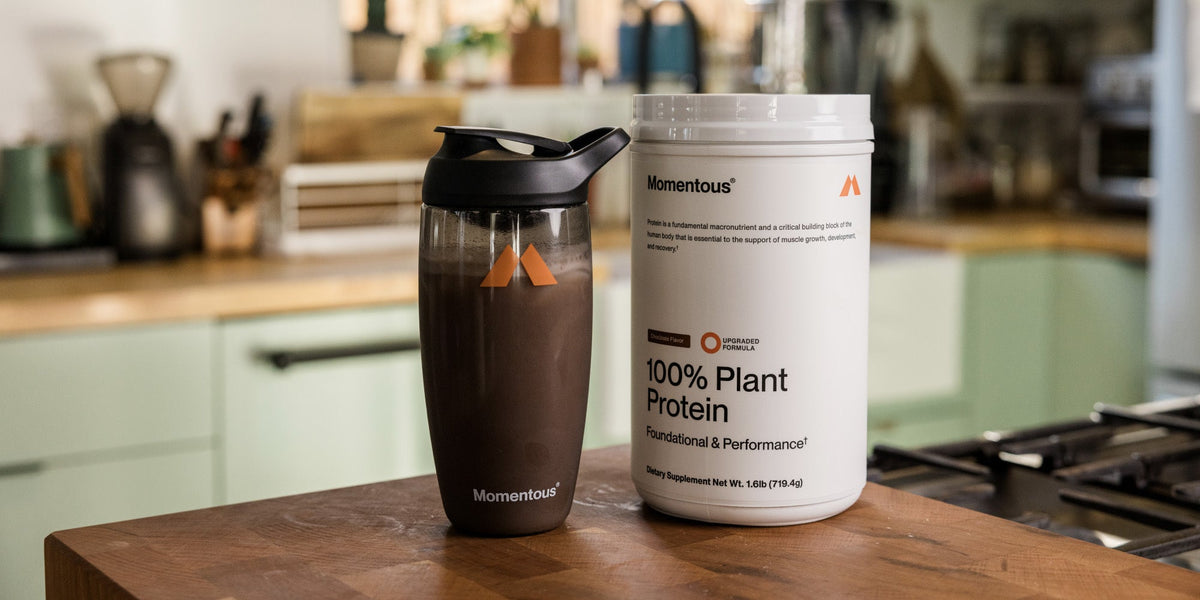
Powering Up with 100% Plant Protein Powder
|
|
In recent years, plant-based diets have surged in popularity, appealing not only to vegans and vegetarians but also to individuals seeking healthier lifestyle choices. One effective way to boost your protein intake on a plant-based diet is by incorporating plant-based protein powder. This guide will explore how to integrate 100% Plant Protein Powder into your diet and provide delicious recipes to help you get started. Even if you are a dedicated Essential Whey user, we encourage you to consider adding some 100% Plant Protein to your routine.
Let’s first clarify the distinctions between a whey protein powder and plant-based protein powder. Whey protein powder has a higher concentration of leucine, an essential branched-chain amino acid vital for stimulating muscle protein synthesis. In contrast, plant-based proteins generally require larger serving sizes to reach the same leucine levels as whey.
However, plant proteins typically offer more fiber and additional phytonutrients. While whey protein is rapidly absorbed—making it ideal for post-workout recovery—plant proteins are absorbed more slowly, providing a steady supply of amino acids over time. Instead of choosing one over the other, consider that both whey and plant-based proteins can effectively support muscle growth and recovery when included in a balanced diet and exercise regimen. In fact, using them together may provide even greater benefits by combining the strengths of both protein sources.
| 100% Plant | Essential Whey | |
|---|---|---|
| Absorption Rate | Gradual | Rapid |
| Higher in Leucine | No | Yes |
| Higher in Fiber | Yes | No |
| Contains Additional Phytonutrients | Yes | No |
| Suitable for Vegans/Dairy Allergies | Yes | No |
Up next are our sourcing notes. Exemplified by our commitment to the Momentous Standard, we take pride in offering thoughtfully formulated products that maximize your potential to push further, harder, and stronger.
Our 100% Plant Protein is crafted from a precise blend of pea and rice proteins, providing a complete amino acid profile. It is low in sugar and purposefully not organic due to the higher heavy metal content often found in organic soil. With 20 grams of protein per serving, it is ideal for creating a protein-packed snack. Plus, it’s great taste and exceptional mixability make it a favorite among high performers who practice a nutritionally balanced plant-based lifestyle.
For those new to protein powder, it may seem like just an inert substance that turns into a thick smoothie when blended with plant milk and berries. However, seasoned food enthusiasts know that protein powder is much more versatile. It serves as a low-calorie source of flavor and protein that can enhance various recipes. Whether you're making overnight oats, pancakes, energy bites, or cookies, adding protein powder can elevate these dishes by boosting both their nutritional value and taste.
Explore our collection of recipes below, specifically designed with 100% Plant protein powder, to hit your daily protein goals.
Ingredients:
1/2 cup rolled oats
1 scoop protein powder
1 cup almond milk (or any plant-based milk)
Toppings: fruits, nuts, seeds, or nut butter
Instructions:
Combine oats, protein powder, and almond milk in a jar.
Stir well and refrigerate overnight.
In the morning, add your favorite toppings.
Ingredients:
1 cup cooked quinoa
1 scoop protein powder
1 cup almond milk
Fresh fruits (e.g., berries, banana)
Instructions:
Warm the quinoa and almond milk in a pot.
Stir in the protein powder until well mixed.
Serve topped with fresh fruits
Ingredients:
2 cups whole wheat flour
1 scoop protein powder
1 tsp baking soda
1 tsp baking powder
1/2 tsp salt
1 cup plant-based milk
1/4 cup unsweetened applesauce
Optional: fruits, nuts or honey for added flavor
Instructions:
Combine dry ingredients, then mix with wet ingredients to form a batter.
Pour into muffin tins and bake at 350 degrees F for about 20 minutes.
Ingredients:
1 cup oat flour (or blended oats)
1 scoop protein powder
1 tablespoon baking powder
Plant-based milk to desired consistency
Instructions:
Mix dry ingredients, then add milk until you reach a pancake batter consistency.
Cook on a skillet until bubbles form, then flip and cook until golden.
Ingredients:
1 frozen banana
1 cup mixed berries
1 scoop protein powder
1/2 cup Greek yogurt
1 tbsp nut butter
1/4 cup milk
Instructions:
Blend all ingredients until thick and creamy.
Top with sliced almonds, chia seeds, or granola.
Ingredients:
1 cup oats
1/2 cup peanut butter (or nut butter)
1 scoop protein powder
Honey to taste
Instructions:
Mix all ingredients in a bowl, roll into balls, and refrigerate for a quick snack.
Ingredients:
3 tablespoons chia seeds
1 scoop protein powder
1 cup almond milk
Sweetener to taste (e.g., maple syrup)
Instructions:
Mix all ingredients in a bowl or jar and refrigerate overnight.
Stir before serving.
Ingredients:
1 cup Greek yogurt
1 scoop protein powder
Optional: cocoa powder or sweetener like honey to taste
Instructions:
Combine all ingredients until smooth for a high-protein dessert.
